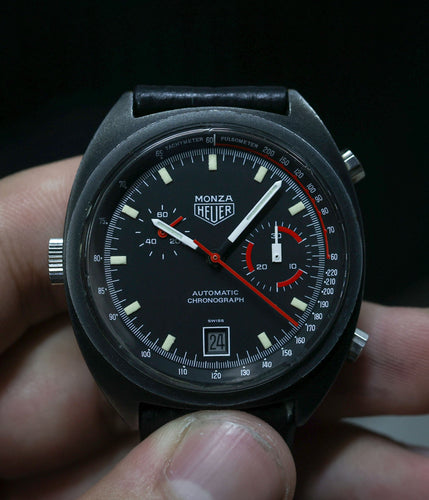
The Heuer Monza: A Timeless Racing Classic
The Heuer Monza roots lie in Formula One racing history, making it a cherished icon amongst collectors.
The Birth of the Heuer Monza – 1975 Origins
The Heuer Monza was first introduced in 1976 to celebrate Ferrari’s dominance in the 1975 Formula One season. Niki Lauda’s victory secured the Drivers’ Championship, while Ferrari claimed the Constructors’ title. This double victory ended an 11-year drought, cementing Ferrari’s resurgence as a racing powerhouse. The Monza Grand Prix in Italy played a key role in Lauda’s success, inspiring the name of this iconic timepiece.
Under the leadership of Jack Heuer, the Monza was conceived as a commemorative watch that would embody the adrenaline of Formula One racing. It became the first Heuer chronograph to feature a black-coated case, utilising a PVD (Physical Vapour Deposition) coating over a brass base. Yes, you read correctly, a brass base. Heuer were always ones to innovate and brass gave the watch a sleek and modern look.
The original Heuer Monza was powered by the Calibre 15 movement, a variant of the Calibre 12 automatic chronograph developed in 1969 through a collaboration between Heuer, Breitling, and Hamilton-Büren. Designed as a more cost-effective alternative to the Calibre 12, the Calibre 15 retained reliability while introducing a distinct and unconventional dial layout.
Its standout features included a small seconds sub-dial at 10 o’clock, a 30-minute chronograph counter at 3 o’clock, and a quick-set date window at 6 o’clock, enhancing both practicality and usability. Despite the asymmetrical sub-dial positioning, the Monza achieved a sense of visual balance through intentional disruption, resulting in a dynamic and striking aesthetic.
Further adding to its uniqueness, the Monza was one of the few Heuer models from the 1970s to feature its name engraved directly on the case back, emphasising its distinctive identity within Heuer’s lineup.
Key design elements of the 1976 Monza included:
• Tachymeter and Pulsometer Scales – Allowing wearers to measure both speed and heart rate, useful for drivers and racing teams.
• Cushion-Shaped Case – Breaking away from traditional round cases, this bold design added a distinctive touch.
• Red and White Dial Accents – Inspired by Ferrari’s iconic colours, ensuring high readability at a glance.
• Domed Crystal – Enhancing legibility and adding a vintage charm.
Despite its sporty design, the Monza remained versatile, making it suitable for both racetracks and everyday wear. Its mix of utility and style helped it quickly gain popularity among motorsport enthusiasts.

Modern Revivals and Updated Designs
Over the years, the Monza has undergone several updates, each retaining the spirit of the original while embracing modern advancements in watchmaking.
• Early 2000s Revival: TAG Heuer revived the Monza in the early 2000s, drawing inspiration from its 1930s chronographs and the 1976 model. These versions maintained the cushion-shaped case but introduced cleaner, more contemporary dials, appealing to modern tastes while preserving vintage aesthetics. We’re not the biggest fans of the first attempt at recreating the classic.
• 40th Anniversary Edition (2016): To celebrate 40 years since the launch of the Monza, TAG Heuer released a faithful reissue. This model featured the classic black-coated case (tick), the vintage Heuer logo (tick), and the combined pulsometer and tachymeter scales (tick and tick) from the original design. Powered by the Calibre 17 automatic movement, it incorporated modern enhancements such as a titanium case for improved durability and lightweight comfort. The 2016 Monza balanced heritage with innovation, making it a collector’s favourite. The racing strap also looks period correct, but matched with a modern Heuer signed deployment clasp. These watches are now coming onto the second-hand market and represent great value. Prices are still quite reasonable, and are only expected to increase in the coming years.
• 2023 Monza Flyback Chronometer: The most recent iteration of the Monza demonstrates TAG Heuer’s commitment to pushing boundaries. It boasts a 42mm carbon case, offering superior strength and reduced weight. The skeletonised dial features translucent blue sapphire crystal chronograph counters, adding a futuristic edge. Powered by the Calibre Heuer 02 Flyback movement, this model allows for resetting the chronograph without stopping it—a feature highly valued in professional racing. Its flyback function and advanced materials make it a high-performance timepiece for modern collectors.
Cultural Impact and Motorsport Legacy
The Heuer Monza holds a special place in TAG Heuer’s history and remains closely associated with Formula One and Ferrari. Its connection to Niki Lauda’s triumph in 1975 and its bold design have cemented its status as a symbol of speed and innovation.
Over the years, the Monza has evolved without losing its racing DNA. It has appealed to both motorsport enthusiasts and style-conscious collectors, bridging the gap between performance and elegance. TAG Heuer’s ability to update the Monza while respecting its origins has ensured its enduring popularity.
Collectability and Investment Value
Vintage Heuer Monza models, especially the 1976 originals, are highly sought after by collectors. Their distinctive design, historical significance, and limited production make them valuable pieces in the secondary market. Modern reissues, such as the 2016 and 2023 editions, have also gained traction, combining vintage appeal with contemporary functionality.
Final Thoughts
From its origins celebrating Ferrari’s dominance in Formula One to its modern-day reinterpretations, the Monza reflects Heuer and TAG Heuer’s commitment to motor racing which continues today with their step back into the world of Formula 1 in 2025. Whether you’re a racing enthusiast or a watch collector, the Monza offers timeless appeal and a rich legacy.
For further details, including the latest models and specifications, visit TAG Heuer’s official website.
